
eGauge: When it comes to energy monitoring, knowledge is power
eGauge: When it comes to energy monitoring, knowledge is power
- posted on: July 16, 2021
- posted by: 21 Acres
"*" indicates required fields

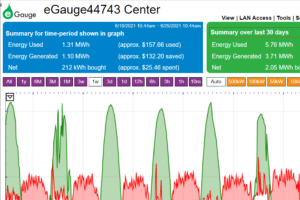
This article was written by Kelly Rankich, Facility Manager.
Is ignorance really bliss? The few times that I have thought that, like on a hike where the tour guide pointed out tarantula holes in the ground, I’m usually wrong. It is good to know where the tarantulas are. And like those tarantulas, knowledge is definitely power when it comes to monitoring energy use.
Energy monitoring means more power to take climate action at home and at work. Not only can you identify problems with equipment that is using excessive energy, but you can optimize the performance of equipment—and your behaviors—to help reduce your overall energy use. Reducing your energy use is beneficial for your pocketbook and even better for the climate.
According to Project Drawdown, globally, electricity production contributes to 25% of Greenhouse Gas (GHG) emissions. And in the US, approximately 62% of our energy production comes from the burning of fossil fuels.
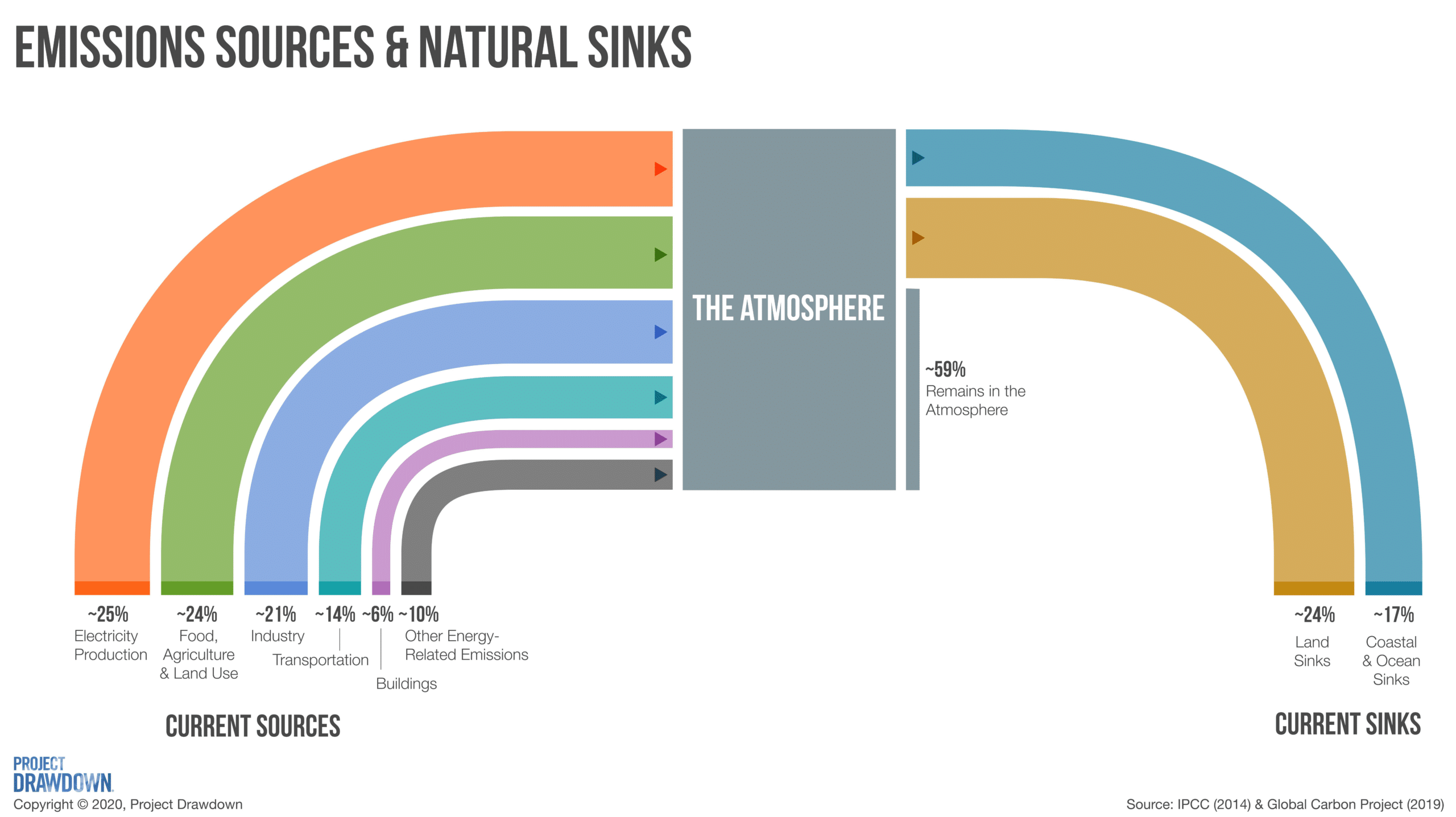
Lowering our energy use has an immediate and direct impact on reducing GHG emissions and the subsequent effect on climate change.
To assist us with this effort at 21 Acres, we have an energy use monitoring system called eGauge. Not only does our system monitor our energy usage, but it also monitors our solar panel production. The system is definitely fun to play with (if you like that sort of thing) and to show our guests. But the primary purpose of the system is for our knowledge of all the systems we have in use at 21 Acres.
eGauge helps us know where the tarantulas in the system are; when something goes haywire, we know what we need to fix. Bottom line: this system helps us conserve energy which reduces our Greenhouse Gas Emissions and our climate impacts.
What is the 21 Acres eGauge system monitoring?
The 21 Acres eGauge energy monitoring system is a circuit monitoring system. We have three separate eGauge units that are monitoring approximately 30 electrical subloads, our solar panel production, and the two main building circuit panel supplied energy.
Even with all of this monitoring capability, we’ve had to make choices of which systems to monitor. Because we’re a home to our Farm Market and a food distribution hub for Puget Sound Food Hub and Farmstand Local Foods, monitoring refrigeration was a top priority. We also decided to monitor some of the higher energy use systems (such as our dishwasher and elevator). Having this knowledge has given us power to find ways to reduce our energy use.
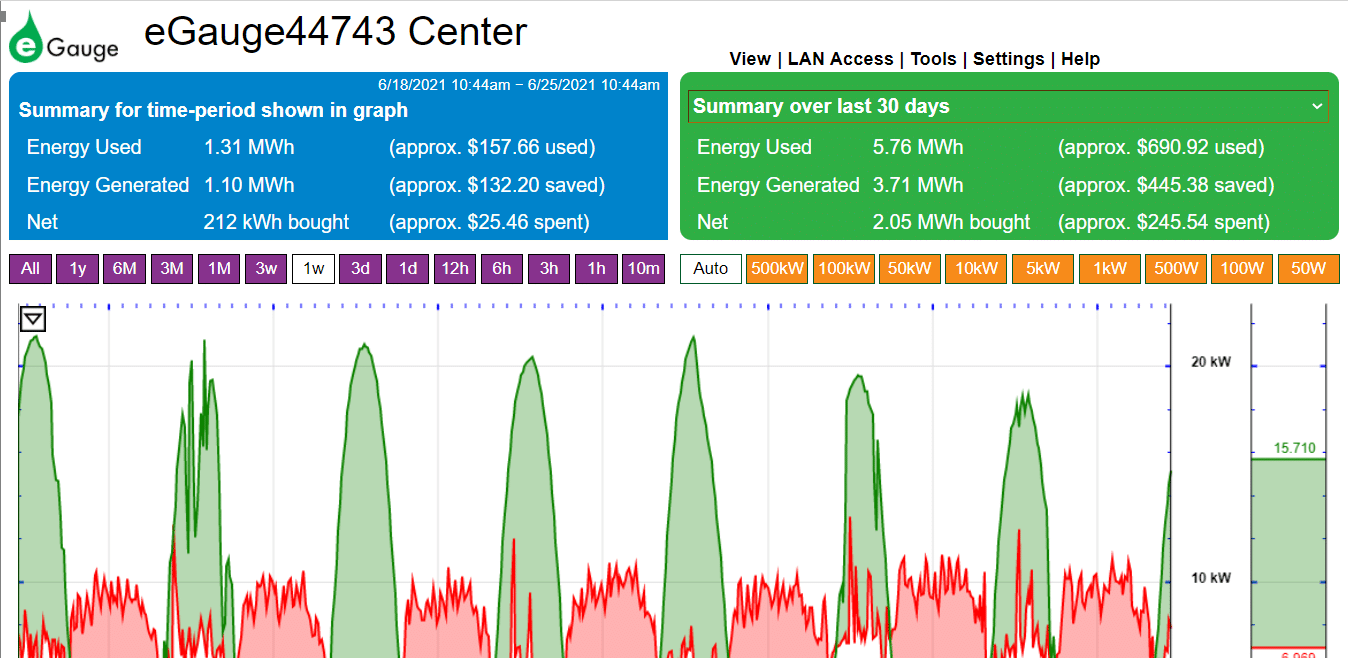
This eGauge display graph from a sunny week in June shows our energy footprint. Here’s a quick breakdown of what we’re looking at:
- Red line and red shading: Our building’s energy use
- Green line: Solar production from our solar array on top of the building
- Green shading: Solar energy we are giving back to the grid
- White areas below the red line: Solar we’re using onsite
In the blue box in the upper left corner, you can see that in this week shown, we generated 1,100 kilowatt-hours (kWh) of solar power and used 1,310 kWh in our building.
The eGauge platform allows us to toggle on and off each system so that we can customize our view. For example, this shows the electrical usage of our dishwasher over the course of one week.
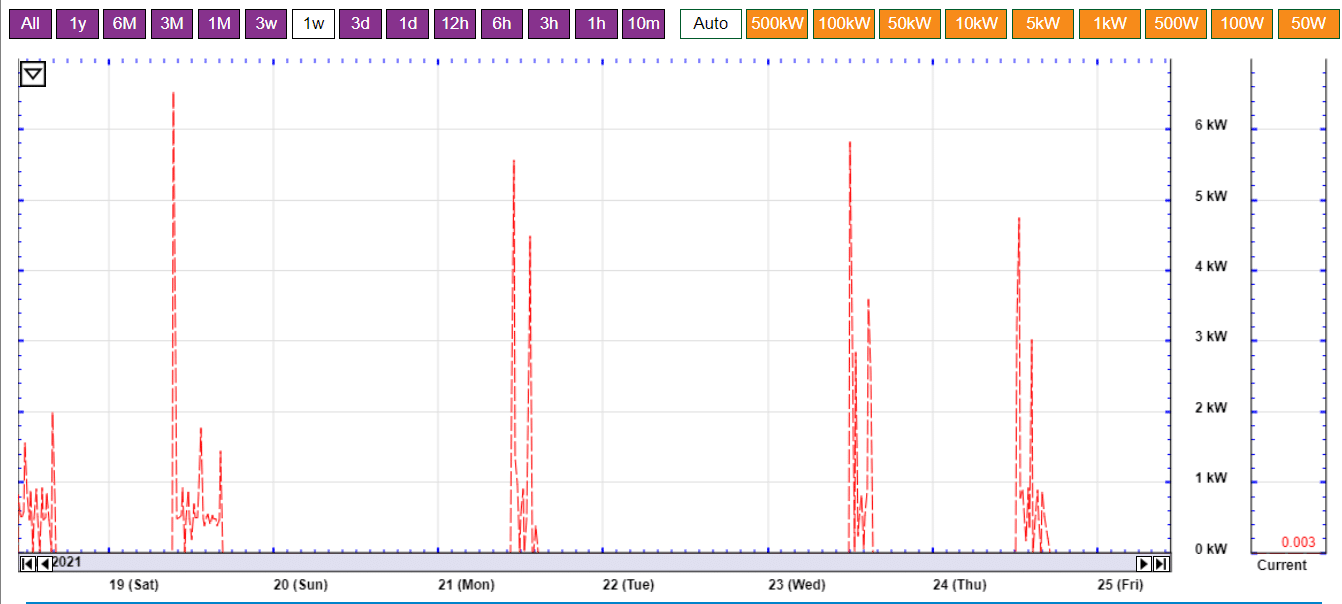
Learn more about our energy monitoring system in the video below.
View the 21 Acres energy gauge real-time
Curious to learn more? We invite you to log onto our website and view our eGauge monitoring system public display. Use the following information to log in: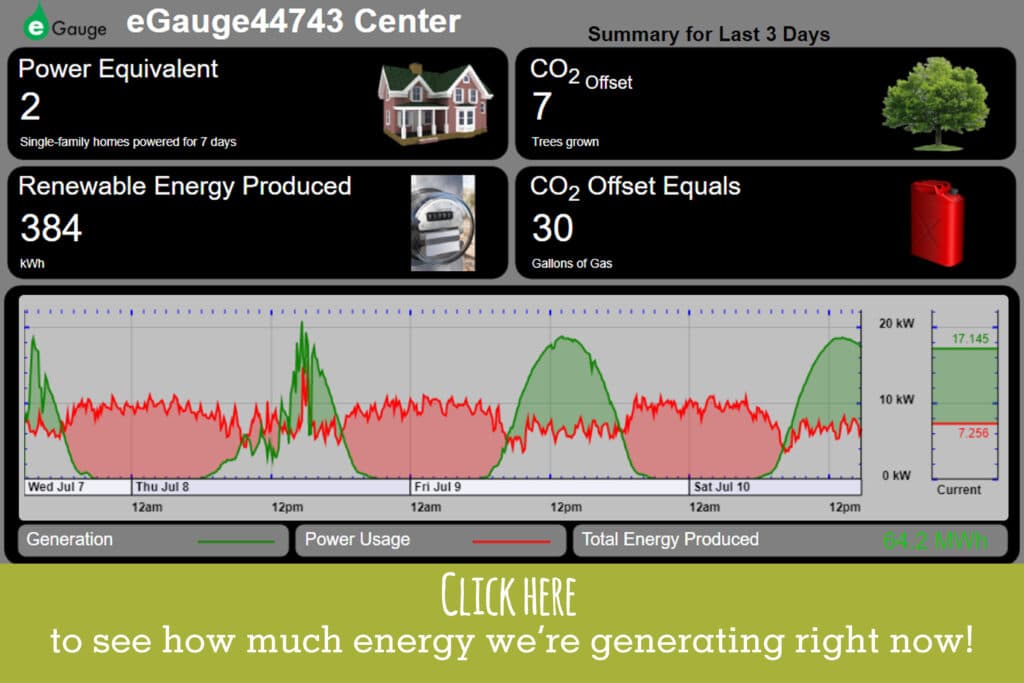
Username: Guest
Password: password
This view shows you our total energy use in real time and fun facts. Did you know that the energy we produced in early July was equivalent to offsetting the carbon dioxide emissions from combusting 30 gallons of gasoline?
Below are a few of the ways we’ve used this energy monitoring knowledge to power 21 Acres.
Harnessing the sun’s power this summer
We are always learning here at the living laboratory that is 21 Acres. A few winters ago, snow damaged the electrical conduit from one of our solar panel arrays. The conduit was repaired, but after reviewing our eGauge solar production data (which is updated in real-time) we were able to identify that one of the arrays was still not producing energy as our solar production was half of typical for that time of year. We were able to get the array back on-line and start making green energy.
Local utility providers can provide daily, sometimes hourly information, but most customers may only glance at their monthly bills and look at the graphic comparing this year to last year or this month to last month. Without our eGauge monitoring system, we might not have caught the problem in a timely fashion and would have missed the opportunity to capture more of those rays.
After working on fixes, last year (2020), we produced 27,000 kWh with our solar panels. Of this, we returned 3,760 kWh to the grid (green shading on the eGauge display). Our two photovoltaic arrays on our roofs (for a total of 25.2 kW) generate approximately 20% of our annual energy use. Our building’s panels produce enough electricity to power approximately two to three average American residential homes per year. During the summer months, when we are returning energy to the grid, we receive credit on our utility bills from Puget Sound Energy using “net metering.” Learn more about our solar panels on our next free building tour.
Troubleshooting problems, changing behavior: The power of power
Our living laboratory is the perfect place to optimize systems with mini experiments. When we installed a new Energy Star-rated dishwasher, we used eGauge to monitor the energy usage for various ways of operating the dishwasher during times of light kitchen use.
First, we tried leaving the commercial dishwasher powered on (which uses energy to maintain the hot water inside), and then tried turning the dishwasher off, draining the water tank, and heating a new reservoir of water for another load later in the day. Using eGauge, we monitored total energy usage over these time periods. It turns out that in our kitchen, it uses less energy to leave the dishwasher powered on if we’re going to be using it later in the day.
Next, we tried another experiment. In our commercial dishwasher, it automatically runs a wash cycle if we close the lid, but we were concerned that leaving it open meant that more energy would be used to keep the water reservoir hot. So, we tried it both ways: First, we finished a load of dishes, opened the lid, removed the clean dishes, and left the lid open over several hours. After checking eGauge for our energy use, we then ran a last load of dishes and closed the lid afterward. Closing the lid meant the dishwasher ran an empty cycle. We found that leaving the lid open, even despite the potential thermal loss, uses less energy than running an empty cycle (and saves us water, too).
This type of awareness could lead to energy (and money!) savings in your home or commercial building.
Monitoring your energy use: Which system is best?
If these experiments have made you curious about your home or commercial building energy use, you’re not the only one. The first thing you’ll need to know is that there are three basic types of energy monitoring systems. Which is best depends on your current electrical system setup and what your goals are:
1) Outlet monitoring: This is the simplest and requires a smart plug (commonly around $20) that you plug into your outlet and then plug your monitoring device into. Smart plugs can also be used to control your device with setting a schedule or voice activation. These are typically used with smaller appliances that run on 120V (unlike your larger appliances that run on 220/240V).
2) Whole Panel monitoring: These devices clamp onto your whole house main energy line and can sense the patterns of use and begin to identify major appliances and energy usage devices (also called appliance recognition).
3) Circuit monitoring: For even more detailed information, these systems have clamps for each individual circuit in your panel. You need to have space in your panel and it likely requires professional installation. You also have to be sure it can monitor your desired number of circuits.
There hybrid systems as well so that you can monitor your main circuits at the panel and then use individual outlet monitors for smaller appliances. This online calculator can help you estimate your energy use. Having an idea of the amount of energy the appliances and systems in your home are using will be useful in determining which energy monitoring system works best for you.
So what’s a watt?
By now you’re probably wondering what a watt is, what a kilowatt is, and what it means for your energy use.

Talking units of energy and power can be confusing and relating it to driving is helpful. A watt (a unit of power) is similar to the idea of a mile per hour (or speed or rate). A hair dryer may be rated for 1,000 watts (or 1 kW) but in order to determine how much electricity it uses, you also need to know how many hours you operate it for (in order to determine the distance you travel, you need both speed and time). Therefore, if your family members spend a half hour drying their hair each day, your hair dryer uses 500 watt-hours per day, or 15,000 watt-hours/month (15 kW-hours/month). These are the values you see on your electrical bill and represent your energy use.
In addition, some appliances draw electricity even when not in use. This is called a “phantom load.” This is common for devices like televisions in order to be in a standby mode or for voice-activated devices. Energy monitoring helps you determine the amount of this phantom load and enables you to make smart decisions, such as unplugging the device or using an electrical power strip and turning it off. Some new homes are being equipped with phantom load wall switches to aid in reducing these “vampire loads.”
The following is an example of the electrical usage of common residential appliances, where the estimated hours of use is a critical component in evaluating total energy usage. How does your use stack up?
Go forth and reduce energy use!
The benefits of energy monitoring are endless. You can evaluate the reduction in energy use, cost savings, and reduction in your carbon footprint for turning down your thermostat, lowering your hot water tank temperature, or asking your kids to take shorter showers. Here at 21 Acres, implementing eGauge even led to changes among our staff—during a demonstration of our eGauge system to employees, one of my colleagues observed the electrical use of the elevator. Even though we have a highly efficient elevator, she decided to take the stairs more often.
Energy use is an important way for us to become aware of the ways our buildings can be solutions to climate challenges. If you’re curious to learn more, I highly recommend PowerWise’s resources. We are always willing to talk energy!
About Kelly Rankich
Kelly is a LEED Green Associate and our Facility Manager. She helps operate and maintain our living laboratory for green building and supports our soil team, market, and various programs. She has a passion for sustainability and reducing her carbon footprint. She is a long-time Woodinville resident, raising her two kids in this community, and is enjoying not having a commute. She grew up on a small 6-acre farm in Wisconsin and completed her MS in Environmental Engineering at Washington State University. She is a proud WSU Snohomish County Extension Sustainable Community Steward. You may catch her giving a Green Building Tour, multi-tasking ten projects at once, or helping set up for an event. When not working, she enjoys the plethora of wineries in Woodinville, music, dancing, and yoga.










 back to blog overview
back to blog overview








